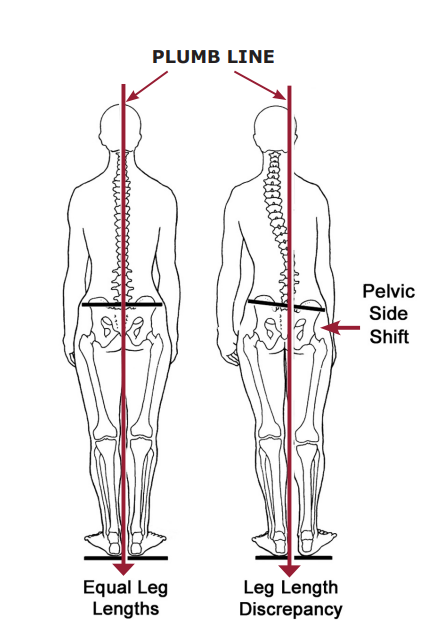Understanding Leg Length Discrepencies: Effects on Posture, Pain, and Spinal Health
Introduction:
In the realm of chiropractic care, understanding the relationship between the musculoskeletal system and its impact on overall health is paramount. One condition that can significantly affect posture, pain, and spinal health is an anatomical short leg. This article will delve into what a leg length discrepancy is, how it can affect your body, and why seeking chiropractic care, especially the Gonstead approach, can be instrumental in addressing these issues.
What is an leg length discrepancy ?
A leg length discrepancy (LLD), refers to a condition in which one leg is shorter than the other due to structural differences in the bones of the lower extremities. It can be categorized into two types: congenital (present at birth) and acquired (developed over time due to injury or other factors). In many cases, the difference in leg length may be subtle, but even a small discrepancy can have significant consequences for your posture and spinal health.
Impact on Posture:
Maintaining proper posture is essential for overall well-being. A short leg can disrupt the body's natural alignment, leading to postural issues such as:
Pelvic Tilt: The shorter leg may cause the pelvis to tilt downward on one side, resulting in an uneven foundation for the spine. This can lead to an array of problems, including lower back pain and hip misalignment.
Spinal Curvature: As the body tries to compensate for the leg length difference, the spine may develop curves or twists to maintain balance. This can contribute to conditions like scoliosis and increased stress on the vertebral discs.
Uneven Weight Distribution: When one leg is shorter, it can cause an uneven distribution of weight across the body. This can lead to overuse of certain muscles, leading to muscle imbalances and discomfort.
Effects on Pain:
A short leg can be a source of chronic pain and discomfort. Some of the common pain-related consequences include:
Lower Back Pain: The misalignment caused by LLD often results in chronic lower back pain, which can be debilitating and affect daily life.
Hip Pain: The uneven pelvis can place additional strain on the hip joints, leading to hip pain and reduced mobility.
Knee Pain: The altered biomechanics of the legs can increase the risk of knee pain, especially in the longer leg, due to increased stress on the joint.
Foot and Ankle Problems: Over time, an anatomical short leg can lead to foot and ankle issues, including plantar fasciitis, as the feet may not distribute weight evenly.
Spinal Health Implications:
The spine is the body's central support structure, and any imbalance can have a cascading effect on its health. A short leg can contribute to various spinal health issues, including:
Degenerative Disc Disease: The abnormal spinal alignment can accelerate the wear and tear of vertebral discs, potentially leading to degenerative disc disease.
Nerve Compression: Misaligned vertebrae can cause the disc and soft tissue to disrupt the spinal nerves, resulting in conditions like sciatica and radiating pain.
How Gonstead Chiropractic Care can help:
At Adapt Spine Centre, we utilize the Gonstead Method of chiropractic care, which focuses on the biomechanical integrity of the spine and its relationship to the nervous system. Our doctors use physical as well as x-ray analysis to help us diagnose if you have pelvic misalignments that can be contributing to a short leg, or if you have an anatomical leg length discrepancy. Chiropractors trained in the Gonstead method can provide targeted adjustments to correct spinal misalignments caused by an anatomical short leg. Through precise adjustments and tailored treatment plans, they aim to restore proper posture, alleviate pain, and improve spinal health.
Conclusion:
Leg Length Discrepancies can have far-reaching consequences on posture, pain, and spinal health. Seeking specialized care from a Gonstead chiropractor can be a vital step in addressing these issues. By restoring proper alignment and balance, chiropractic care can help patients lead healthier, pain-free lives and improve their overall well-being. If you suspect you may have a leg length discrepancy, consult with a chiropractor to explore your treatment options and start your journey toward better health.


